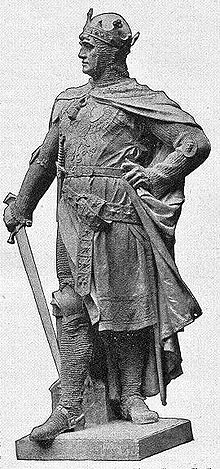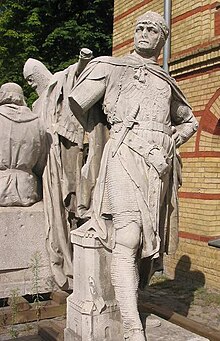Albrecht II (Brandenburg)

Albrecht II. (* Before 1177; † February 25, 1220 ) was Margrave of Brandenburg (1205–1220).
Life
The Ascanian Albrecht II was Otto I's youngest son and nobility, since 1176 Otto I's second wife, as well as the grandson of Albrecht the Bear , the purchaser of the Mark Brandenburg .
Albrecht II took over the reign in 1205 after the death of his older brother Otto II .
Since 1184 Albrecht II. Count von Arneburg was in the Altmark claimed by Otto II and belonging to Brandenburg . In 1194 he was captured by Margrave Otto II and temporarily imprisoned. Before that, Albrecht, now around seventeen, had started a guerrilla war against his half-brother and plundered his land in order to enforce his claims to co-reign in the Mark. Reconciliation came about at the latest in 1195, since then we have seen him mentioned many times in documents at the side of Margrave Otto, who also officially designated him as his heir.
Albrecht took part in the so-called German Crusade of Henry VI. and was present at the founding meeting of the Teutonic Order in 1198 in Akkon .
In the throne disputes between the Staufers and Guelphs at the beginning of the 13th century, Albrecht initially supported - like his brother Otto before him - the Staufer King Philip of Swabia . After his murder in 1208, he went over to the Guelphs because of the now completely changed political situation in the Saxon area, as Emperor Otto IV promised him support in securing the Margraviate of Brandenburg against the Danes, which he confirmed in a document in 1212.
During this time Albrecht was repeatedly involved in disputes with Archbishop Albrecht I of Magdeburg . He also played an important role in the Brandenburg tithe dispute .
Albrecht II secured the regions of Teltow , Prignitz and parts of the Uckermark for the Mark Brandenburg, but lost Pomerania .
In order to settle the long-standing war against Denmark, which was unfavorable for Brandenburg, for supremacy in the south-western Baltic Sea region, he was forced to make a permanent peace with the northern great power. A marriage project between his first-born daughter Mechthild and the young Duke Otto from Lüneburg - a nephew of the Danish king who temporarily grew up at the Danish court - was supposed to create the necessary conditions.
If the grandfather Albrecht the Bear is considered the founder of the Mark Brandenburg and the father Otto I as the promoter and guide of the settlement movement, Stephan Warnatsch sums up the sons:
“[They] continued the process of territorialization that had been initiated and began at the end of the 12th century, when the influx of settlers grew more and more in the course of the eastward movement and thus many more" staff "were available for the development of the country in the Ruppin and Lander especially Barnim and Teltow. In addition, the Oder and the southern Uckermark were targets of the Ascanian expansion efforts. But everywhere one came into conflict with the claims of competing princes. "
When he died, his two sons were still minors. Archbishop Albrecht von Magdeburg took over the feudal guardianship, and from 1221 the mother, Countess Mathilde. Since their death in 1225, the brothers ran the margraviate together.
Marriage and offspring
Albrecht was married since 1205 to Mathilde von Groitzsch (1185-1225), daughter of Margrave Konrad II (Lausitz) from the Wettin family and the Polish duke's daughter Elisabeth from the line of the Wielkopolska Piast . He had four children with her:
- Mechthild (* 1206; † June 10, 1261), ⚭ 1228 Guelph Duke Otto I of Lüneburg (* 1204; † 1252), also called Otto the child
- Elisabeth (* 1207; † November 19, 1231), ⚭ 1228 Landgrave Heinrich Raspe of Thuringia (* 1201; † 1247)
- Johann I. (* approx. 1213; † April 4, 1266)
- Otto III. the pious (* 1215 - † October 9, 1267)
Monument to Albrecht II in Berlin's Siegesallee
The Albrecht monument stood in the former Siegesallee in the Tiergarten in Berlin , the “splendid boulevard” commissioned by Kaiser Wilhelm II in 1895 with monuments from the history of Brandenburg and Prussia. Between 1895 and 1901, under the direction of Reinhold Begas , a total of 27 sculptors created 32 statues of the Brandenburg and Brandenburg-Prussian margraves, each 2.75 m high. Each statue was flanked by two smaller busts depicting people who had played an important role in the life of the respective ruler or in the history of Brandenburg / Prussia.
For monument group 4 , these were the busts of Eike von Repgow , the author of the Sachsenspiegel , and of Hermann von Salza , Grand Master of the Teutonic Order. As Albrecht's participation in its founding meeting shows (see above), he had established a close relationship with the Teutonic Knights Order, which was based on the same political objectives with regard to the eastern territories. He had already met Hermann von Salza on the Palestine Crusade and deepened the relationship throughout his life - the choice of the secondary character should express this relationship.
According to Gustav Albrecht, neither Albrecht II nor the Mark Brandenburg were connected to Eike von Repgow. The choice of the secondary character is probably due to the fact that the Sachsenspiegel, as the most important legal book of the German Middle Ages, also had a great influence on Brandenburg and Northern Germany. However, Eike had a close connection to the house of the Ascanians, because he was in the service of Heinrich I , Prince of Anhalt.
The sculptor of the monument group was Johannes Boese (1856–1917). The unveiling took place on March 22, 1898.
Gustav Albrecht described the Albrecht monument in 1900 as follows:
“The margrave, in chain armor with his hood turned up, is seen in a combat-ready position, as he protects a castle with drawn swords, probably the border fortress of Oderberg, which was built in 1215. The head of the energetic prince is adorned with a narrow crown ring; A wide decorative belt is looped around the weapon shirt adorned with the Brandenburg eagle, a long coat, held together by the left hand, falls down picturesquely to the back. "
literature
- Gustav Albrecht: Margrave Albrecht II. In: Richard George (Ed.): Hie good Brandenburg all way! Historical and cultural images from the past of the Mark and from old Berlin up to the death of the Great Elector. Published by W. Pauli's Nachf., Berlin 1900
- Helmut Assing: Brandenburg, Anhalt and Thuringia in the Middle Ages. Ascanians and Ludovingians building princely territorial rule. Böhlau Verlag, Cologne 1997. ISBN 3-412-02497-X
- Helmut Assing: The early Ascanians and their wives. Bernburg 2002
- Lutz Partenheimer : Albrecht the Bear - founder of the Mark Brandenburg and the Principality of Anhalt. Böhlau Verlag, Cologne 2001, ISBN 3-412-16302-3 .
- Jörg Rogge : The Wettins. Thorbecke Verlag, Stuttgart 2005, ISBN 3-7995-0151-7 .
- Hans Spichalski: Heinrich Raspe IV of Thuringia - landgrave and counter-king. Books on Demand , Norderstedt 2009, ISBN 978-3-8370-5288-6 , p. 96 ff.
- Stephan Warnatsch: History of the Lehnin Monastery 1180–1542, Studies on the History, Art and Culture of the Cistercians , Volume 12.1. Lukas Verlag, Berlin 2000, ISBN 3-931836-45-2 (also: Berlin, Free University, dissertation, 1999).
- Otto von Heinemann : Albrecht II (Margrave of Brandenburg) . In: Allgemeine Deutsche Biographie (ADB). Volume 1, Duncker & Humblot, Leipzig 1875, p. 243.
- Willy Hoppe: Albrecht II. In: New German Biography (NDB). Volume 1, Duncker & Humblot, Berlin 1953, ISBN 3-428-00182-6 , p. 161 ( digitized version ).
Individual evidence
- ^ Regest of the Margraves of Brandenburg from Ascanian house: Hermann Krabbo, First Delivery, Dunker & Humblot, Leipzig 1910, page 120, certificate # 565
- ↑ Warnatsch, p. 26.
- ↑ Exact data from: Ziegler, Anton (Ed.), Historical Memorabilia of Home and Abroad, Volume 1, Lechner's University Bookstore, Vienna 1846, Chapter 82, right column.
- ↑ Gustav Albrecht, p. 88 f.
| predecessor | Office | successor |
|---|---|---|
| Otto II. |
Margrave of Brandenburg 1205–1220 |
Johann I and Otto III. |
| personal data | |
|---|---|
| SURNAME | Albrecht II. |
| BRIEF DESCRIPTION | Margrave of Brandenburg (1205-1220) |
| DATE OF BIRTH | around 1150 |
| DATE OF DEATH | February 25, 1220 |

